No matter how fashion changes, they will always remain in trend knitted dresses made with crochet for women.
The patterns and styles presented in the article will help needlewomen choose the best model for a certain type of figure. And additional details and decorative trims will act as elements that emphasize the advantages or hide the disadvantages of female forms.
Crochet dress with floral motifs
The crochet dress for women, the patterns of which are presented below, looks amazing due to the alternation of floral and round motifs. They are connected by a smaller flower motif.
For knitting such a model, thin mercerized cotton thread is best suited. It is possible to use cotton yarn, which contains a small percentage of viscose or acetate fiber. Optimal hook sizes are 0.5-2.5.
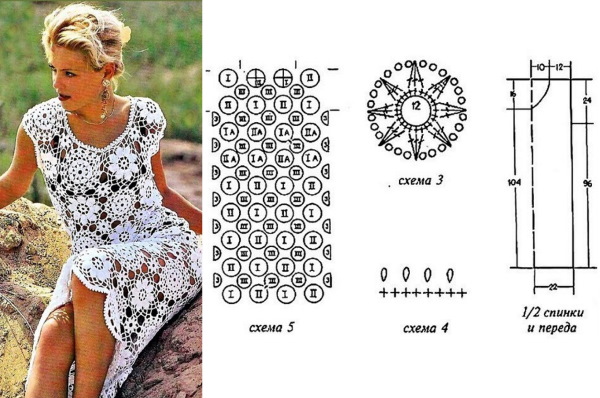
 The presented dress is a straight silhouette. This style is well suited for women of medium and slender build. The color scheme can be a wide range, from snow-white to black. You can also use a combination of 2 or more colors.
The presented dress is a straight silhouette. This style is well suited for women of medium and slender build. The color scheme can be a wide range, from snow-white to black. You can also use a combination of 2 or more colors.
In order to correctly calculate the required number of full motifs corresponding to the required size, before starting work, you should make a sample of 4 large motifs (2 floral and 2 round) and one connecting flower. After its completion, carry out wet-heat treatment and only then compare its width and length with the measurements taken.
If there is a slight discrepancy between the width of the sample and the main girth (the largest horizontal girth used for the calculation), an allowance of 3-4 cm for free fit is allowed. This is used if the distance to the full motif is not enough equal to the allowance.
If the width of the full elements is much larger than the required size, then the motif itself should be adjusted.
This can be done in two ways:
- Take a hook of a smaller number and knit the same fragment. By decreasing the hook thickness, the density of the pattern increases and its diameter decreases.
- If you don’t like the resulting density, you can reduce the number of outer rows or rows inside the motif to the required size.
Then you can start the main work. According to the masters, it is most convenient to knit in a circle. That is, alternately, according to the pattern, first place large round and floral motifs. Then knit small flowers and tie them between the large ones.
Then again a series of basic elements and so on. After the dress is completely knitted, the edges are decorated with a series of single crochets with air piques, as shown in the diagram. At the end, the finished product is wet-heat treated.
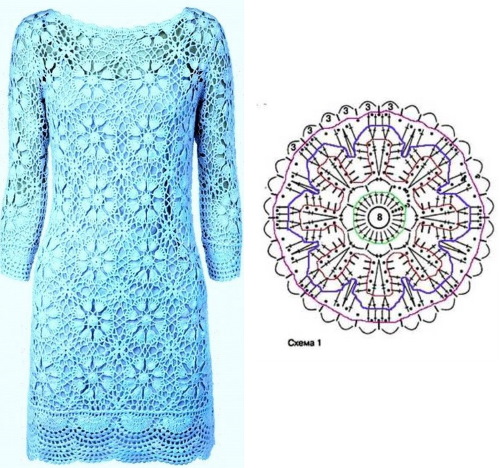
The dress on the next model, crocheted for women with a proportional figure and detailed patterns for it, also represents a set of fabric from floral motifs of two types, large and small. The second ones play the role of filling the inter-motif space.
The threads and hook numbers used are similar to the first option. The simplicity of knitting this model, in relation to the previous dress, is that there are 2 motifs in the fabric, not 3. But its complexity is that when knitting the neck and sleeves, half-motifs are used.
Before you start knitting a dress, you must make a sample. Then match the number of motifs to the pattern you made and start working. In order not to make a mistake when knitting large floral motifs, the direction of the rows is shown in the diagram with lines of different colors.

The connection of elements into a single fabric can be done both when knitting the outer row of the motif, and at the end of the work, when the required number of them has been accumulated. The layout of the dress fragments is also presented. Inter-motif floral fragments are also knitted in both during the work and after its completion.
After completing the main parts of the front, back and sleeves, they should be ironed. Then, using markers, secure the places of the intended shoulder seams with the centers of the sleeve caps and the intended side seams with the sleeve seams. Then sew the latter in evenly and carefully.
The final operation will be the design of the open edges. The bottom of the dress and sleeves are tied with a border according to the presented pattern. The neck can be tied with one or two rows of single crochet stitches, and then secured with a row of "crayfish step".
From square motifs
The following model is easier to perform. It is made of square motifs. The ease of knitting is that apart from the square fragments, nothing else needs to be knitted. There are no inter-motif spaces in this technique.
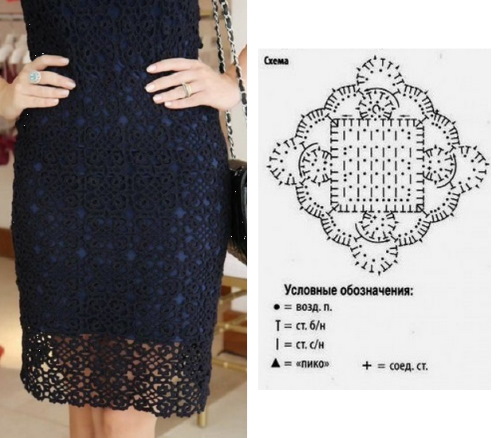
But there is also a difficulty when doing this fabric in black. The pattern is poorly visible on it and it is very easy to make a mistake in the pattern, but it is quite difficult to notice it. When knitting a product from black yarn, it is advisable to place a white cloth or towel under the work to facilitate visual contact.
To calculate the required number of full squares corresponding to the measurement taken, it is enough to complete one motif. The elements are joined along the perimeter during the work process. The finished dress is moistened and ironed.
The crochet dress for women, the patterns and the template for which are offered below, is a combined version. It interestingly combines square motifs of one color, creating a central openwork part, with inserts of a solid fabric of a different color. Visually, such a model gives a woman slimness and adds height.
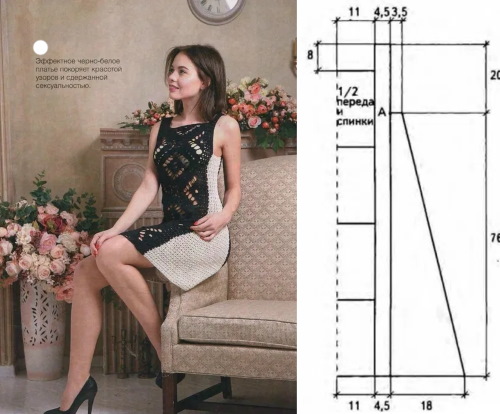
 The square motif of this model is the case when it is a component of another large pattern. For this version of the dress, you can use different yarns. It can be thin and cotton with the addition of impurities or acrylic with a small wool content.
The square motif of this model is the case when it is a component of another large pattern. For this version of the dress, you can use different yarns. It can be thin and cotton with the addition of impurities or acrylic with a small wool content.
To obtain a weaker knitting density, it is recommended to use hooks 1 - 1.5 numbers larger. Based on their diagram, the silhouette of the dress flares out towards the bottom. Since the side parts of this model must be knitted from top to bottom, therefore, loops will be added.
How to do this is shown in the following diagram. Moreover, the addition occurs not in the center, along the side seam line, but along the edges, which will subsequently be sewn with the central parts. This type of expansion will allow the seamless side parts to acquire smooth curves that repeat the woman's physique.
Fillet
A very delicate and unusually beautiful dress made using the fillet technique.

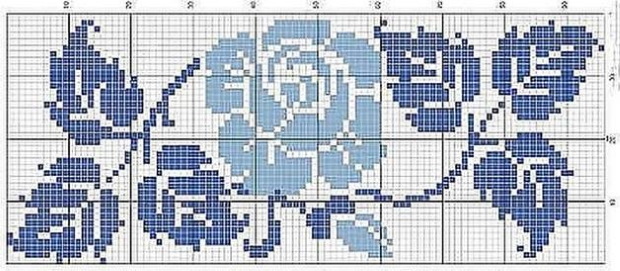 Alternating horizontal stripes of small openwork patterns and floral fillet compositions will emphasize the advantages of a woman's slender figure. For such a dress, the best yarn option would be thin cotton threads and a hook with No. 0.5 -1. The color range is extensive.
Alternating horizontal stripes of small openwork patterns and floral fillet compositions will emphasize the advantages of a woman's slender figure. For such a dress, the best yarn option would be thin cotton threads and a hook with No. 0.5 -1. The color range is extensive.
The fillet technique is a grid that is made in the form of small squares by alternating double crochets and air loops. An ornament is applied to it by filling, according to the schemes, certain cells. According to the advice of experienced craftsmen, this process can be carried out with 2 and 3 double crochets in one cell.
But at the same time, they should have one top to avoid breaking the pattern. This is done so that the pattern on the grid looks clearer and more natural. Carefully follow the pattern when knitting reverse rows (purl) so as not to distort the pattern. It is not particularly difficult to compare the details made in the fillet technique with the pattern made.
With a round yoke
A crochet dress for women (pattern diagrams and a pattern for it represent one of the simplest knitting options) is made from a single piece of fabric, which is knitted in a circle.
The following are used for such products:
- cotton yarn, both pure and with impurities;
- silk;
- acetate.
The hooks are selected according to the selected yarn. Their numbers can vary from 1 to 3. Work begins from the neck. The length of the initial chain should be equal to the neck circumference measurement. After knitting the pattern according to the presented scheme to a width reaching the armpit, you should proceed to making the main fabric of the dress.
To do this, it is recommended to fold the yoke in half and mark the armholes with markers. Then measure the distance between them. If it matches the chest measurement, you can continue knitting. If the distance is less than the required size, you can increase it by making an additional chain at the joints of the armholes with the main fabric.

After reaching the required width, you should move on to another pattern and knit until you reach the length of the dress. It can be chosen independently according to the woman's desire and figure. After finishing the work, you can decorate the edges of the product with additional binding and carry out wet-heat treatment.
The model of the dress with a round yoke presented below looks charming. It is made using the Bruges lace technique. Its technology consists of creating a symmetrical and complex ornament from a solid knitted braid by joining certain arcs, located alternately on both sides.
To make items in this technique, it is recommended to use thin cotton or acrylic yarn and the appropriate hook No. 1-2. Making the tape is very simple. It consists of knitting 3-4 (depending on the width of the tape) double crochets and arcs of air loops when lifting to the next row. Its diagram is presented below.
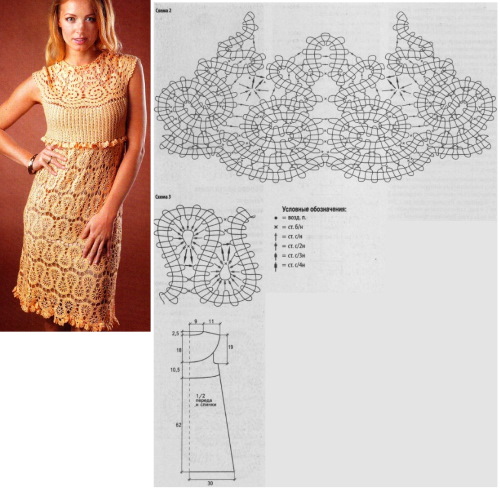
The yoke is a symmetrical connection of the braid into successive curls in accordance with the diagram below. It ends at the back with a fastener on hanging loops and buttons in the same color as the dress.
When subsequently moving from the openwork yoke to a similar but simpler pattern from the same braid, you can use any other pattern that does not distract attention from the parts with Bruges lace. It should be knitted from the top down.
After reaching the high waistline mark, you need to start making similar lace. It is done sequentially, row by row. When knitting the first of them, in addition to making curls, they connect it to the edge of the previous pattern.
To make the width of the product in the hip area a little wider, it is drawn a little thicker than the pattern requires. The second row should be knitted as shown by the tape of the first row. That is, each subsequent arc of the curl should be connected to each loop of the curl of the previous tier.
After finishing the work, it is recommended to decorate the neckline, the bottom of the dress and the place where the patterns join on the high waist with a border in the form of a narrow gathered frill.
Summer dress with a sun skirt
This dress model is a combination of a bodice knitted from round floral motifs and a sun-flared skirt with a high waist made of a single piece of fabric with longitudinal stripes.
This style will favorably emphasize the upper part of the figure and hide minor flaws in the hip area due to the loose cut of the skirt. Also, the height will be visually increased due to the longitudinal stripes of the selected pattern. The most optimal option for the yarn used will be thin cotton mercerized thread and a hook with No. 1-1.5.
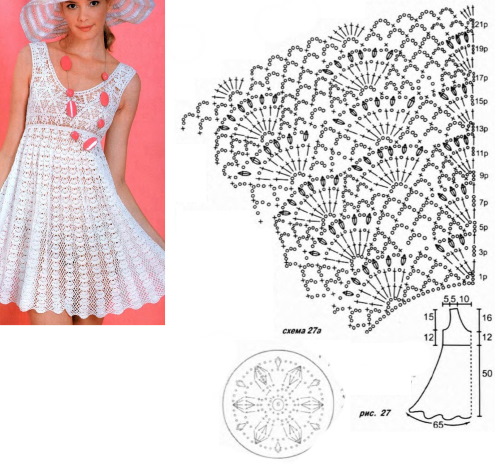
When making the bodice, namely the wide straps, in addition to full round motifs, you will also need half motifs. To make them without mistakes, you should clearly divide the presented pattern in half and, in the process of knitting, when lifting to the next row, dial 3 air loops. The bodice in this model can be either one-piece or have a clasp at the back.
The skirt is knitted from the top down from the bodice. When casting on the first row of the main pattern, the stitches should be tightened so that later it creates a pleated effect. The lower part of the dress can be knitted in a circle or in straight and back rows, then sewn together at the back.
If the dress does not have a fastener and is a little loose for better putting on, to emphasize the top, you can use a satin or knitted braid. It is recommended to thread it through the row of the connection of the skirt with the bodice and tie it in the front or back as desired.
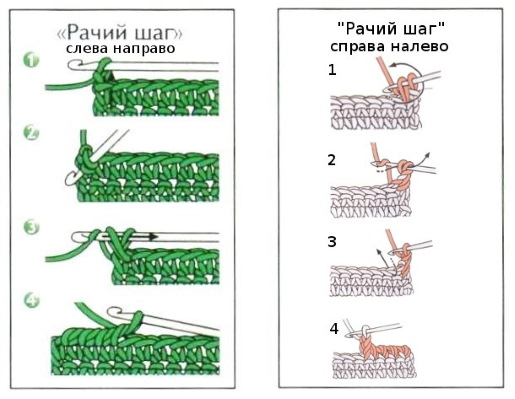
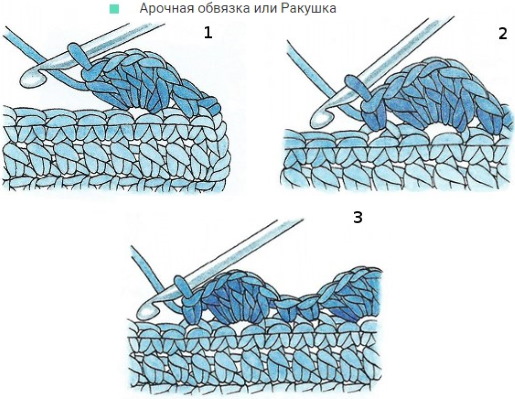
After finishing knitting the skirt, there is no need to decorate its lower edge. The basic pattern will be enough. But it is advisable to tie the neckline and armholes with 2-3 alternating rows of single crochets with double crochets. Finish the design with a row of "crayfish step". It will provide good density of the edge and protect the product from stretching during further use.
With a flared skirt
The crochet dress for women, the patterns for which are presented below, has a flared skirt made in a combination of contrasting colors. This gives it a special charm.
Being a warmer option, it is made of medium-thick yarn containing both cotton and viscose, as well as acrylic and wool. For such threads, it is better to use hooks with No. 2.5-3.5. A higher knitting density is not acceptable for this model.

The top of the dress is made with the pattern shown in the diagram. Following the pattern made according to the measurements taken, decrease the stitches to shape the neckline, armholes and sleeve caps.
When knitting the latter, it is advisable to periodically apply them to the finished armhole to avoid unnecessary rows. This can subsequently lead to a significant discrepancy between the length of the armhole and the sleeve cap. The fastener located in the front can be either a working one or an imitation.
The flare of the skirt is made according to individual desire. This should be regulated by the frequency of rapports at a certain interval at the beginning of knitting. The knitted belt, made of contrasting yarn, contains several wide loops through which a braided cord of threads of the main color is threaded.
When using acrylic-wool yarn, heat treatment of the product should be used with particular caution due to its possible deformation.
With an openwork pattern on the back
An interesting model of a business and at the same time elegant dress is presented below. Its elegance is created by openwork inserts on the back, in the neck area and on the sleeves. For knitting such a model, yarn of medium thickness and the same twist is preferable. It can be mercerized cotton or cotton thread with viscose. It is advisable to use hooks No. 2-3.
The main fabric of the product should be made according to the presented pattern. In case of a large discrepancy in the hip and waist circumferences, it is possible to adjust the width of the longitudinal stripes of the pattern along the lines of the side seams.
When reaching the armhole level, it is necessary to make a smooth decrease in loops for further sewing of sleeves into them. Openwork fragments are made in the process of knitting individual parts of the dress and only after that they are connected into a whole product.

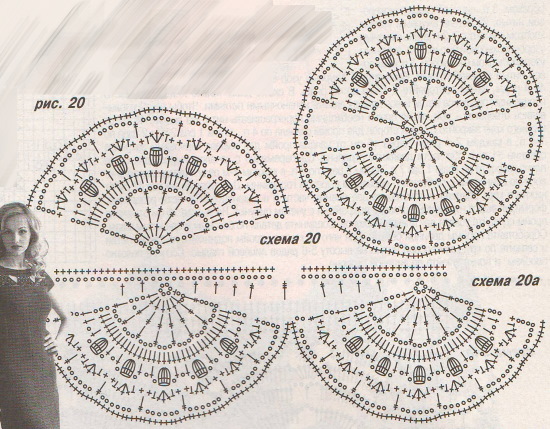

The motifs in this model are used both in full size and in half. They are not performed in a circle, but in straight and reverse rows. Only in full elements when knitting the penultimate and last rows is knitting in a circle used.
The locations of full and half motifs can be seen in the diagram provided. The space between motifs is designed as desired. It can be an irregular or fillet mesh, as well as a thin braid of Bruges lace. For decorative finishing, it is possible to use beads or seed beads in the tone of the dress.
Wet-heat treatment of the finished product should be carried out with caution and from the reverse side.
Tight fitting
This feminine tight dress is a model made using the ribbon lace technique. Knitting the ribbons themselves is not very difficult. The main thing is to carefully follow the selected scheme and make the correct preliminary calculation of the number of tapes.

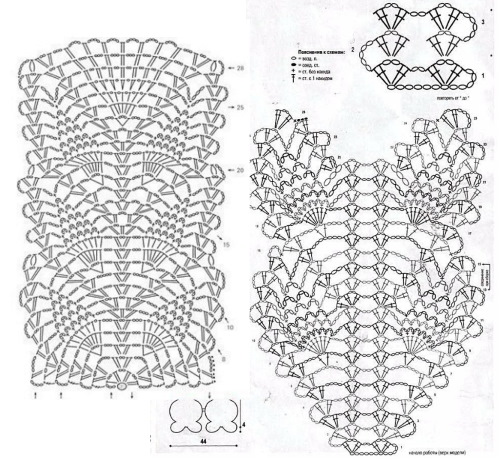 It is desirable that it be even. If this is impossible according to the pattern and the knitted sample, it is recommended to review the tape and choose a narrower or, conversely, wider one. When everything is in accordance, you can start working.
It is desirable that it be even. If this is impossible according to the pattern and the knitted sample, it is recommended to review the tape and choose a narrower or, conversely, wider one. When everything is in accordance, you can start working.
When starting to make the second and subsequent ribbons, according to the masters, it is better to join them during the work, and not after its completion. This will look more neat and practical. During knitting, it is necessary to carefully monitor the correspondence of the lengths of the ribbons in the area of the shoulder seams and the neck.
Short
The presented model is a chic version of a light elegant openwork dress. It can be made of thin cotton, acetate and silk threads. The hook, accordingly, is required under No. 1-2. The fabric of the dress is knitted with a solid pattern, therefore it is possible to use silk and acetate yarn due to its flowability when working with individual motifs.

The pattern scheme is simple. The main rule is to always make a small sample before work and carefully calculate the number of full rapports corresponding to the size of the pattern. Only after this can you safely start knitting.
Next, the manufactured parts are steamed and joined into a finished product. The bottom of the dress and sleeves are decorated with a figured edging, the diagram of which is also presented. Thermal treatment of the product made of silk threads should be carried out carefully and through an iron.
Warm crochet dress
The following model will be a great option for warm spring and autumn days. It is best made from medium-thick yarn containing wool or lint-free mohair. Hooks can be used under No. 2.5-3.5.
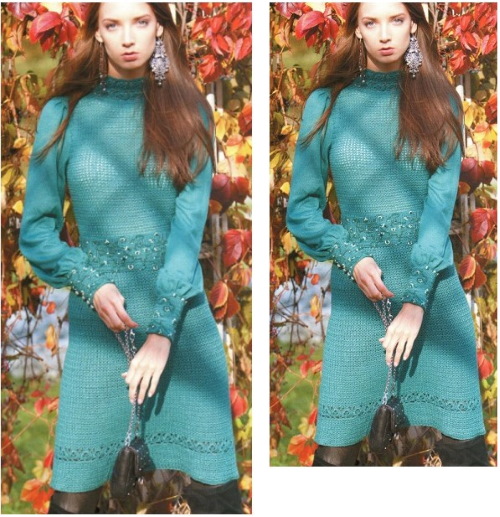
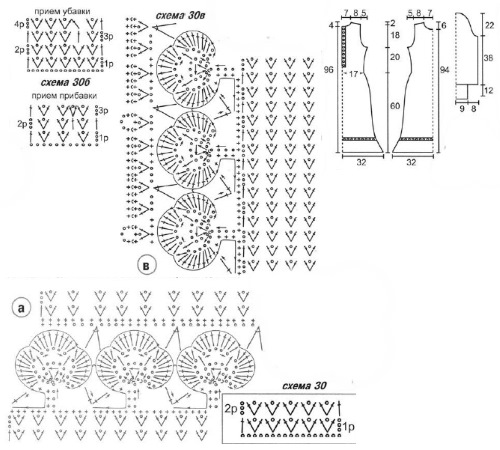 The knitting density of such fabric should not be strong, otherwise the dress will be rough and uncomfortable. Therefore, it is initially recommended to try the yarn and select the optimal hook number. The attached diagram shows the method of making the main pattern, as well as decreasing and increasing loops in the necessary areas of the product.
The knitting density of such fabric should not be strong, otherwise the dress will be rough and uncomfortable. Therefore, it is initially recommended to try the yarn and select the optimal hook number. The attached diagram shows the method of making the main pattern, as well as decreasing and increasing loops in the necessary areas of the product.
The openwork fastening of the dress is carried out on hanging loops and bead buttons and is located at the back. The decorative stand-up collar, insert-belt and cuffs on buttons, the patterns for which are also presented, complement the product with an elegant entourage. When knitting these elements, small beads and large beads, matched to the tone of the main yarn, can be introduced into the pattern.
Finished items made of threads containing wool or mohair should be washed very carefully and in warm water by hand. Dry horizontally on a flat surface.
Using the presented models of crocheted dresses for women, practicing using the proposed patterns to make various patterns, and also listening to the advice of experienced craftsmen, you can get a lot of pleasure, benefit and positive emotions almost from the first product.
Video about crocheting women's dresses
Crochet dress for women:
